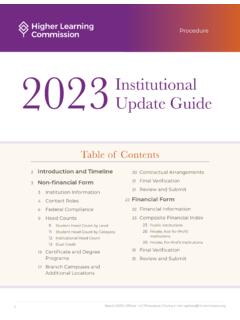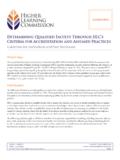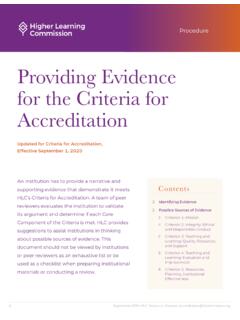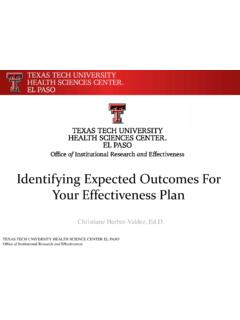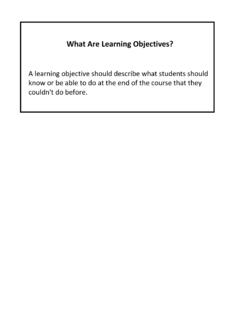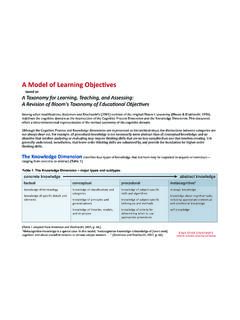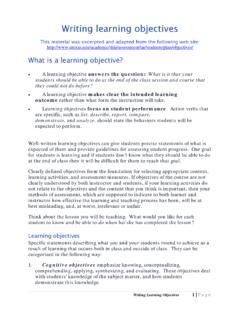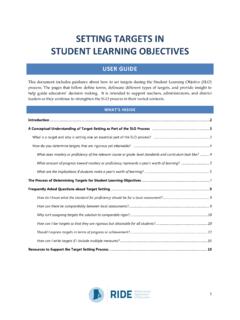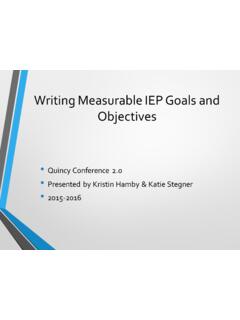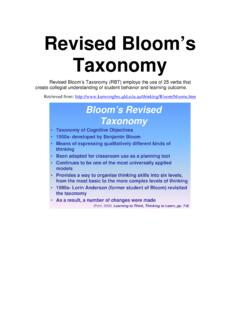Transcription of Determining Qualified Faculty Through HLC’s Criteria for ...
1 GUIDELINESD etermining Qualified Faculty Through HLC s Criteria for Accreditation and Assumed Practices Guidelines for Institutions and Peer ReviewersIntroductionThe following information provides guidance to institutions and peer reviewers in Determining and evaluating minimal Faculty qualifications at institutions accredited by HLC. These guidelines explain the Criteria for Accreditation and Assumed Practices that speak to the importance of institutions employing Qualified Faculty for the varied and essential roles that Faculty members perform. HLC s requirements related to Qualified Faculty seek to ensure that students have access to Faculty members who are experts in the subject matter they teach and who can communicate knowledge in that subject to their students.
2 When an institution indicates that a Faculty member is Qualified by means of an offer of employment, it is asserting its confidence in the Faculty member s content expertise along with the ability of the Faculty member to help position students for success not only in a particular class, but also in their academic program and their careers after they have completed their program. The following guidelines apply to all Faculty members whose primary responsibility is teaching, including part-time, adjunct, dual credit, temporary and/or non-tenure-track Faculty . An institution committed to effective teaching and learning should be able to demonstrate consistent procedures and careful consideration of qualifications for all instructional Faculty .
3 This demonstrates academic integrity and is verifiable Through peer review on HLC s Qualified Faculty RequirementsTogether, HLC s Criteria for Accreditation and Assumed Practices define the quality standards that all member institutions must satisfy to achieve and maintain HLC accreditation. In June 2015, HLC revised Assumed Practice to ensure academic quality by requiring institutions to demonstrate that Faculty members who deliver college-level content are appropriately Qualified to do so, and to ensure that institutions establish clear policies and consistent procedures to achieve such quality. It must be noted that the revisions to Assumed Practice reflect longstanding HLC expectations that had appeared in various written forms in previous years and that Through this revision process, HLC sought to support its mission of assuring and advancing the quality of higher HLC s Board of Trustees approved the revisions to Assumed Practice in June 2015, it also extended the date of compliance to September 1, 2017, to allow institutions time to work Through the 1 September 2020 | Official HLC Guidelines | Contact: The institution s HLC staff liaisondetails of the requirement and to bring their Faculty into compliance Through individual professional development plans.
4 Later, during its meeting in November 2015, the Board acted to allow institutions with dual credit programs to apply for a five-year extension to bring Faculty for those programs into compliance with Assumed Practice In June 2020, the Board extended the deadline for those institutions by one year, to September 1, 2023, due to the disruptive effects of the COVID-19 these guidelines, HLC seeks to offer important additional perspective on Assumed Practice and to convey its expectations and timeline for compliance. The guidelines provide information related to earned Faculty credentials, tested experience and dual credit. Further, these guidelines seek to clarify the role of peer reviewers in Determining the minimal qualifications of Faculty teaching at institutions accredited by S COMMITMENT TO THE IMPORTANCE OF Qualified FACULTYCore Component refers to the Faculty and staff needed for effective, high-quality programs and student services, which entails, in part, a Faculty member s ability to understand and convey the essentials of a specific discipline in a collegiate environment.
5 Minimally Qualified Faculty should be able to engage professionally with colleagues regarding the learning objectives for program graduates, as well as possess the knowledge, skills and dispositions appropriate to the credential awarded. HLC expects that Through the curricula and learning contexts that Faculty develop, the exercise of intellectual inquiry and the acquisition, application and integration of broad learning and skills are integral to an institution s educational programs. Qualified Faculty should also be aware of student learning Through the ongoing collection and analysis of appropriate data, because an institution should be able to demonstrate its commitment to educational achievement and improvement Through ongoing assessment of student learning .
6 It is important to note that none of these abilities are intended to substitute for content expertise or tested experience, as described : See HLC s Criteria 3 and 4 (specifically, and ) for more information on expectations regarding teaching and Criteria and Assumed PracticesCriterion 3 speaks to Faculty qualifications, specifically Core Component , subcomponents , , and Assumed Practice and are also central to this 3. TEACHING AND learning : QUALITY, RESOURCES, AND SUPPORT[Effective September 1, 2020.]The institution provides quality education, wherever and however its offerings are Component The institution has the Faculty and staff needed for effective, high-quality programs and student services. The institution has sufficient numbers and continuity of Faculty members to carry out both the classroom and the non-classroom roles of Faculty , including oversight of the curriculum and expectations for student performance; establishment of academic credentials for instructional staff; involvement in assessment of student All instructors are appropriately Qualified , including those in dual credit, contractual, and consortial The institution has processes and resources for assuring that instructors are current in their disciplines and adept in their teaching roles; it supports their professional PRACTICE B.
7 TEACHING AND learning : QUALITY, RESOURCES, AND SUPPORT[Effective September 1, 2017.] Faculty Roles and Qualificationsa. Qualified Faculty members are identified primarily by credentials, but other factors, including but not limited to equivalent experience, may be considered by the institution in Determining whether a Faculty member is Qualified . Instructors (excluding for this requirement teaching assistants enrolled in a graduate program and supervised by Faculty ) possess an academic degree relevant to what they are teaching and at least one level above the level at which they 2 September 2020 | Official HLC Guidelines | Contact: The institution s HLC staff liaisonteach, except in programs for terminal degrees or when equivalent experience is established.
8 In terminal degree programs, Faculty members possess the same level of degree. When Faculty members are employed based on equivalent experience, the institution defines a minimum threshold of experience and an evaluation process that is used in the appointment process. Faculty teaching general education courses, or other non-occupational courses, hold a master s degree or higher in the discipline or subfield. If a Faculty member holds a master s degree or higher in a discipline or subfield other than that in which he or she is teaching, that Faculty member should have completed a minimum of 18 graduate credit hours in the discipline or subfield in which they Instructors teaching in graduate programs should hold the terminal degree determined by the discipline and have a record of research, scholarship or achievement appropriate for the graduate Assurance Expectations in Determining Minimally Qualified FacultyAccreditation agencies expect that accredited institutions will use credentials as the primary mechanism to ascertain minimal Faculty qualifications.
9 HLC recognizes that experience also may be considered in Determining Faculty qualifications. (See page 4.) In some situations, a combination of these may be appropriate. USING CREDENTIALS AS A BASIS FOR Determining MINIMALLY Qualified FACULTYF aculty credentials refer to the degrees that Faculty have earned that establish their credibility as content experts and thus their competence to teach that content in the classroom. Common expectations 1 Assumed Practice refers to academic subfields. An academic subfield refers to a component of the discipline in which the instruction is delivered. The focus, in the context of HLC accreditation, is on the courses being taught and the general appropriateness of Faculty qualifications with reference to such courses.
10 The key consideration is whether a degree in the field or a focus in the specialization held by a Faculty member appropriately matches the courses the Faculty member would teach in accordance with the conventions of the academic Faculty credentials in higher education include the following: Faculty teaching in higher education institutions should have completed a program of study in the discipline or subfield1 (as applicable) in which they teach, and/or for which they develop curricula, with coursework at least one level above that of the courses being taught or developed. Completion of a degree in a specific field enhances an instructor s depth of subject matter knowledge and is easily identifiable. With the exception noted in the bullet immediately following, Faculty teaching in undergraduate programs should hold a degree at least one level above that of the program in which they are teaching.
